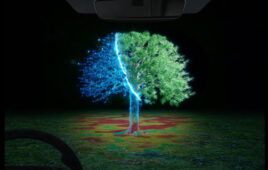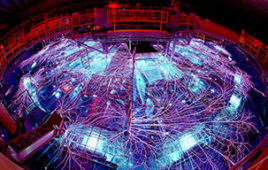 Fiber optic cables have been turned into a quantum lab: Scientists are trying to build optical switches at the smallest possible scale in order to manipulate light. At the Vienna Univ. of Technology, this can now be done using a single atom. Conventional glass fiber cables, which are used for internet data transfer, can be interconnected by tiny quantum systems.
Fiber optic cables have been turned into a quantum lab: Scientists are trying to build optical switches at the smallest possible scale in order to manipulate light. At the Vienna Univ. of Technology, this can now be done using a single atom. Conventional glass fiber cables, which are used for internet data transfer, can be interconnected by tiny quantum systems.
Light in a bottle
Professor Arno Rauschenbeutel and his team at the Vienna Univ. of Technology capture light in so-called “bottle resonators”. At the surface of these bulgy glass objects, light runs in circles. If such a resonator is brought into the vicinity of a glass fibre which is carrying light, the two systems couple and light can cross over from the glass fiber into the bottle resonator.
“When the circumference of the resonator matches the wavelength of the light, we can make one hundred percent of the light from the glass fibre go into the bottle resonator—and from there it can move on into a second glass fiber,” explains Arno Rauschenbeutel.
A rubidium atom as a light switch
This system, consisting of the incoming fiber, the resonator and the outgoing fiber, is extremely sensitive:
“When we take a single rubidium atom and bring it into contact with the resonator, the behaviour of the system can change dramatically,” says Rauschenbeutel. If the light is in resonance with the atom, it is even possible to keep all the light in the original glass fibre, and none of it transfers to the bottle resonator and the outgoing glass fibre. The atom thus acts as a switch which redirects light one or the other fiber.
Both settings at once: The quantum switch
In the next step, the scientists plan to make use of the fact that the rubidium atom can occupy different quantum states, only one of which interacts with the resonator. If the atom occupies the non-interacting quantum state, the light behaves as if the atom was not there. Thus, depending on the quantum state of the atom, light is sent into either of the two glass fibres. This opens up the possibility to exploit some of the most remarkable properties of quantum mechanics: “In quantum physics, objects can occupy different states at the same time,” says Arno Rauschenbeutel. The atom can be prepared in such a way that it occupies both switch states at once. As a consequence, the states “light” and “no light” are simultaneously present in each of the two glass fiber cables.
 For the classical light switch at home, this would be plain impossible, but for a “quantum light switch,” occupying both states at once is not a problem.
For the classical light switch at home, this would be plain impossible, but for a “quantum light switch,” occupying both states at once is not a problem.
“It will be exciting to test, whether such superpositions are also possible with stronger light pulses. Somewhere we are bound to encounter a crossover between quantum physics and classical physics,” says Rauschenbeutel.
This light switch is a very powerful new tool for quantum information and quantum communication.
“We are planning to deterministically create quantum entanglement between light and matter,” says Arno Rauschenbeutel. “For that, we will no longer need any exotic machinery which is only found in laboratories. Instead, we can now do it with conventional glass fibre cables which are available everywhere.”
Abstract: Fiber-Optical Switch Controlled by a Single Atom
Full paper: Fiber-Optical Switch Controlled by a Single Atom
Source: Vienna Univ. of Technology




